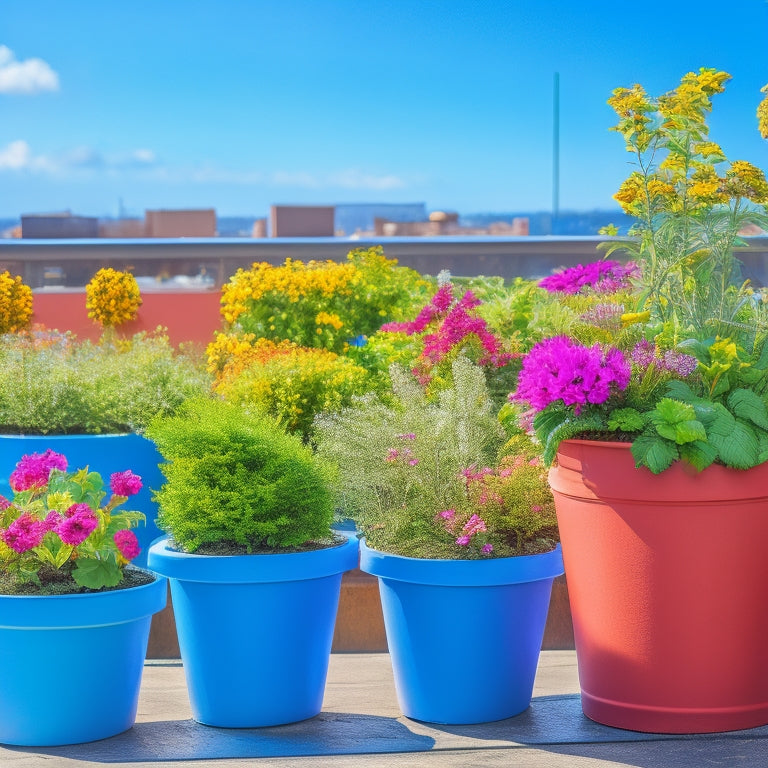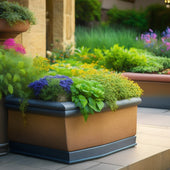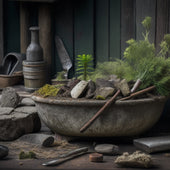
What to Plant in a Rooftop Container Garden?
Share
You can create a thriving rooftop container garden by choosing the right plants that thrive in your local climate and meet the unique challenges of rooftop growing conditions, such as intense sunlight, wind, and temperature fluctuations. Consider compact or dwarf perennials like creeping thyme, sedum, and catmint for low-maintenance spring blooms, or try patio tomatoes, bush beans, and baby cucumbers for a summer harvest. Fragrant herbs, succulents, and drought-resistant species also do well in rooftop containers. By selecting plants with varying growth habits, textures, and seasonal interests, you'll enjoy a dynamic rooftop garden that changes with the seasons - and there's more to explore to make it truly flourish.
Key Takeaways
• Select compact or dwarf perennials and annuals that thrive in containers and rooftop conditions.
• Incorporate seasonal interest plants, such as spring bulbs, summer veggies, and winter evergreens, for year-round color.
• Choose plants with varying textures, shapes, and sizes to create visual appeal and diversity in the garden.
• Consider low-maintenance, pollinator-friendly, and drought-resistant species that can tolerate rooftop conditions.
• Ensure proper air circulation, growth space, and drainage in containers to support plant health and growth.
Spring Blooms for Rooftop Containers
As you prepare your rooftop container garden for the new growing season, selecting spring-blooming flowers that thrive in containers will kick-start a vibrant display of color and texture.
When choosing perennials, consider varieties that are compact or dwarf, as they'll perform better in containers. Look for flowers like creeping thyme, sedum, or catmint, which are low-maintenance and can tolerate rooftop conditions. These plants will provide a beautiful foundation for your container arrangements.
For a pop of color, add some spring-blooming annuals like pansies, violas, or snapdragons. These flowers will bloom quickly and provide a burst of color before the perennials take over.
When arranging your containers, remember to balance heights, textures, and colors to create visual interest. Consider a mix of upright, mounding, and trailing plants to add depth and dimension. Don't forget to leave space for proper air circulation and growth.
With these spring-blooming flowers, your rooftop container garden will be off to a stunning start.
Summer Veggies in Small Spaces
By cleverly selecting and arranging summer veggies in small spaces, you can maximize your rooftop container garden's productivity while enjoying a bountiful harvest. Start by choosing compact varieties of vegetables that are specifically bred for small spaces, such as patio tomatoes, bush beans, and baby cucumbers. These varieties will thrive in containers and won't overcrowd your rooftop garden.
Next, consider incorporating vertical gardening techniques to make the most of your space. Train vining vegetables like peas, squash, and cucumbers to climb up trellises or arbors, or use wall-mounted planters to add extra growing space. This won't only increase your yield but also add visual interest to your rooftop garden.
When arranging your containers, group plants by their growing requirements, such as sun exposure and watering needs. Make sure to leave enough space between containers for air circulation and easy access for harvesting.
With careful planning and attention to detail, you'll be enjoying a fresh and abundant summer harvest from your rooftop container garden in no time.
Fall Foliage Container Ideas
You can extend the life of your rooftop container garden into the fall season by incorporating plants that showcase vibrant autumn colors and textures. This will add depth and visual interest to your outdoor space as the seasons change.
To create a stunning fall display, consider the following plants:
-
Ornamental Kale: Its frilly, curly leaves come in a range of autumn colors, from deep reds to soft whites, and add a delicate texture to your containers.
-
Coral Bells: With their dainty, bell-shaped flowers and maple-like leaves in shades of bronze, copper, and crimson, coral bells bring a pop of color to your rooftop garden.
-
Sedum: This low-maintenance succulent boasts thick, fleshy leaves in shades of gold, orange, and red, adding a unique texture to your containers.
When selecting plants, remember to choose varieties that thrive in your local climate and provide the necessary care, such as adequate sunlight and watering.
Winter Interest for Rooftops
To maintain visual appeal during the winter months, incorporate plants that provide structural interest, berries, or evergreen foliage into your rooftop container garden. These elements will add depth and visual interest to your space, even when the temperatures drop.
Consider plants like ornamental grasses, which offer winter textures and seasonal contrasts that will add variety to your containers. You can also incorporate evergreen shrubs like boxwood or holly, which will provide year-round interest.
If you want to add some color, plant winter-flowering heather or cyclamen, which will bloom in shades of pink, white, or purple. Don't forget to include some berry-producing plants like wintergreen or holly, which will attract birds and add a pop of color to your containers.
Fragrant Herbs for Containers
When designing your rooftop container garden, you'll want to contemplate incorporating fragrant herbs to elevate the sensory experience.
You can create an enchanting atmosphere by selecting herbs that release their aromas when touched or brushed against, such as those with scented leaves.
Scented Leaf Delights
Fragrant herbs like lemon balm, sweet marjoram, and scented geranium thrive in containers, filling the air with their enchanting aromas. These herbs are perfect for your rooftop container garden, as they're easy to care for and can tolerate a range of conditions. Plus, their scented foliage will add an extra layer of sensory delight to your outdoor space.
When choosing fragrant herbs for your containers, consider the following:
-
Scented geraniums: These lovely plants have beautiful flowers and fragrant leaves that release a sweet, floral aroma when touched.
-
Lemon balm: With its light, citrusy scent and delicate white flowers, lemon balm is a great addition to any container garden.
-
Sweet marjoram: This herb has a piney, slightly sweet fragrance and tiny white flowers that attract pollinators.
Potpourri Perfume Mix
By combining scented geranium, lemon balm, and sweet marjoram in your container garden, you'll create a Potpourri Perfume Mix that will envelop your rooftop oasis with a complex, alluring aroma.
These fragrant herbs are ideal for containers, as they thrive in well-draining soil and partial shade. Scented geranium adds a sweet, floral note, while lemon balm contributes a light, citrusy scent. Sweet marjoram rounds out the blend with its piney, herbal aroma.
When planted together, these herbs create a harmonious potpourri blend that will fill your rooftop garden with natural fragrances. You can prune them regularly to encourage bushy growth and prevent them from becoming leggy.
To enhance their scent, consider placing the container in a spot that receives gentle breezes, which will carry the fragrance throughout your rooftop oasis. With minimal care, your Potpourri Perfume Mix will provide a constant source of delightful aromas, making your rooftop container garden a true retreat.
Aromatic Border Edges
To create visually appealing and aromatic border edges in your rooftop container garden, plant a selection of fragrant herbs, such as thyme, rosemary, and oregano, around the perimeter of your pots. This will add a beautiful and fragrant touch to your containers. You can use these herbs to create herbal borders that won't only add visual interest but also provide aromatic accents to your rooftop oasis.
Here are three benefits of using fragrant herbs as border edges:
-
Fragrance: Fragrant herbs like lavender and rosemary will release their sweet aroma when touched or brushed against, creating a sensory experience in your rooftop garden.
-
Pest control: Certain herbs, such as thyme and oregano, have natural pest-repelling properties that can help keep unwanted insects away from your plants.
-
Low maintenance: Most fragrant herbs are low-maintenance and can thrive in containers with minimal care, making them an ideal choice for busy gardeners.
Succulent Containers for Rooftops
You'll need containers with excellent drainage when planting succulents on rooftops, as these plants are highly susceptible to root rot in waterlogged soil. This is essential because rooftops often receive full sun and experience strong winds, which can exacerbate waterlogging issues.
When selecting containers, look for ones with built-in drainage holes or add a layer of small rocks or broken pottery at the bottom to facilitate water flow.
To create a stunning succulent container arrangement, choose a mix of drought-resistant species with varying textures, shapes, and sizes. Consider combining upright succulents like aloe or agave with trailing ones like sedum or echeveria.
Add some visual interest by incorporating different container sizes, shapes, and colors. Make sure to leave enough space between plants for air circulation and growth.
Year-Round Color Containers
When creating year-round color containers, you'll want to select plants that provide interest during each season.
By incorporating spring-flowering bulbs, summer-blooming annuals, and winter evergreen interest, you'll guarantee your rooftop garden remains vibrant and engaging throughout the year.
Spring Flowering Bulbs
In rooftop container gardens, spring-flowering bulbs add vibrant color and texture, emerging from their winter slumber to herald the new growing season. You can enjoy a stunning display of colors with the right bulb selection and planting tips.
When choosing bulbs, consider varieties that thrive in containers, such as tulips, daffodils, and hyacinths. Look for bulbs that are specifically labeled as 'container-friendly' or 'compact' to guarantee they won't outgrow your rooftop space.
Here are some essential tips to keep in mind:
-
Plant bulbs in the fall: About 6-8 weeks before the first frost, plant your bulbs in a well-draining potting mix, with the pointed end facing up.
-
Choose the right pot size: Select a pot that's at least 6-8 inches deep to accommodate the bulbs' growth.
-
Water sparingly: Water your bulbs sparingly during the winter months, as overwatering can lead to rot.
Summer Blooming Annuals
As the spring-flowering bulbs fade, summer-blooming annuals take center stage, providing a vibrant splash of color to your rooftop container garden with minimal maintenance.
These sunshine lovers thrive in the warm weather, requiring at least six hours of direct sunlight to bloom profusely.
When selecting summer annuals, consider pollinator plants like marigolds, zinnias, and sunflowers that attract bees, butterflies, and hummingbirds to your rooftop oasis.
You can also opt for heat-tolerant varieties like petunias, impatiens, and coleus that will continue to bloom throughout the summer months.
For added visual interest, combine annuals with different growth habits, such as upright, trailing, or spreading varieties.
Don't forget to choose a well-draining potting mix and containers with good drainage holes to prevent waterlogged soil.
With proper care, your summer-blooming annuals will provide a stunning display of color and texture to your rooftop container garden, creating a vibrant and inviting space to relax and enjoy.
Winter Evergreen Interest
You can extend the color season of your rooftop container garden by incorporating winter evergreen interest, which provides year-round structure and visual appeal. This is especially important in winter when most plants are dormant, and your garden might look bare. By incorporating evergreen plants, you can maintain a visually appealing garden even in the dead of winter.
Here are three ways to add winter evergreen interest to your rooftop container garden:
-
Choose evergreen shrubs: Select compact, dwarf, or slow-growing evergreen shrubs that can thrive in containers, such as boxwood, holly, or lavender.
-
Incorporate evergreen perennials: Plant perennials with attractive evergreen foliage, like sedum, creeping thyme, or sweet woodruff, which provide year-round interest and can be paired with seasonal color.
-
Add evergreen textures: Incorporate a variety of evergreen textures, like ferns, grasses, or conifers, to add depth and visual interest to your containers.
Frequently Asked Questions
How Often Should I Water My Rooftop Container Garden?
'Like a conductor orchestrating a symphony, you'll need to fine-tune your watering techniques to guarantee your rooftop container garden thrives. Check container drainage daily, and water when the top inch of soil feels dry to the touch, usually every 2-3 days.'
Can I Use Regular Potting Soil in Containers?
You shouldn't use regular potting soil in containers, as it can retain too much water, causing poor drainage; instead, opt for a well-draining potting mix specifically designed for containers to guarantee healthy plant growth.
What Is the Ideal Container Size for a Rooftop Garden?
You're wondering what size container is ideal for your rooftop garden, but don't rush - first, consider the weight and durability of container materials, plus clever drainage solutions, to guarantee your masterpiece thrives.
Do I Need to Fertilize My Rooftop Container Plants?
You'll need to fertilize your rooftop container plants regularly, as potting mix lacks essential nutrients. Choose a balanced, water-soluble fertilizer or a slow-release formula to replenish container nutrients, ensuring healthy growth and bloom.
How Do I Protect My Containers From Extreme Winds?
You'll want to secure your containers from fierce gusts by installing wind barriers, like trellises or screens, and ensuring container stability by weighing them down with heavy materials or anchoring them to the rooftop.
Related Posts
-

3 Best Tool Essentials for Creative Concrete Planters
To create visually stunning and durable concrete planters, you'll need three essential tool categories. First, you'll...
-

3 Best Tool Essentials for Creative Concrete Planters
To create visually stunning and durable concrete planters, you'll need three essential tool categories. First, you'll...
-

3 Best Tool Essentials for Creative Concrete Planters
To create visually stunning and durable concrete planters, you'll need three essential tool categories. First, you'll...
-

3 Best Tool Essentials for Creative Concrete Planters
To create visually stunning and durable concrete planters, you'll need three essential tool categories. First, you'll...
-

3 Best Tool Essentials for Creative Concrete Planters
To create visually stunning and durable concrete planters, you'll need three essential tool categories. First, you'll...
-

3 Best Tool Essentials for Creative Concrete Planters
To create visually stunning and durable concrete planters, you'll need three essential tool categories. First, you'll...
-

3 Best Tool Essentials for Creative Concrete Planters
To create visually stunning and durable concrete planters, you'll need three essential tool categories. First, you'll...
-

3 Best Tool Essentials for Creative Concrete Planters
To create visually stunning and durable concrete planters, you'll need three essential tool categories. First, you'll...
-

3 Best Tool Essentials for Creative Concrete Planters
To create visually stunning and durable concrete planters, you'll need three essential tool categories. First, you'll...
-

3 Best Tool Essentials for Creative Concrete Planters
To create visually stunning and durable concrete planters, you'll need three essential tool categories. First, you'll...
-

3 Best Tool Essentials for Creative Concrete Planters
To create visually stunning and durable concrete planters, you'll need three essential tool categories. First, you'll...
-

3 Best Tool Essentials for Creative Concrete Planters
To create visually stunning and durable concrete planters, you'll need three essential tool categories. First, you'll...
-

3 Best Tool Essentials for Creative Concrete Planters
To create visually stunning and durable concrete planters, you'll need three essential tool categories. First, you'll...
-

3 Best Tool Essentials for Creative Concrete Planters
To create visually stunning and durable concrete planters, you'll need three essential tool categories. First, you'll...
-

5 Essential Drainage Tips for Block Planters
When using block planters, you'll want to guarantee effective drainage to prevent waterlogging and root rot. Start by...
-

5 Essential Drainage Tips for Block Planters
When using block planters, you'll want to guarantee effective drainage to prevent waterlogging and root rot. Start by...
-

5 Essential Drainage Tips for Block Planters
When using block planters, you'll want to guarantee effective drainage to prevent waterlogging and root rot. Start by...
-

5 Essential Drainage Tips for Block Planters
When using block planters, you'll want to guarantee effective drainage to prevent waterlogging and root rot. Start by...
-

5 Essential Drainage Tips for Block Planters
When using block planters, you'll want to guarantee effective drainage to prevent waterlogging and root rot. Start by...
-

5 Essential Drainage Tips for Block Planters
When using block planters, you'll want to guarantee effective drainage to prevent waterlogging and root rot. Start by...
-

5 Essential Drainage Tips for Block Planters
When using block planters, you'll want to guarantee effective drainage to prevent waterlogging and root rot. Start by...
-

5 Essential Drainage Tips for Block Planters
When using block planters, you'll want to guarantee effective drainage to prevent waterlogging and root rot. Start by...
-

5 Essential Drainage Tips for Block Planters
When using block planters, you'll want to guarantee effective drainage to prevent waterlogging and root rot. Start by...
-

5 Essential Drainage Tips for Block Planters
When using block planters, you'll want to guarantee effective drainage to prevent waterlogging and root rot. Start by...
-

5 Essential Drainage Tips for Block Planters
When using block planters, you'll want to guarantee effective drainage to prevent waterlogging and root rot. Start by...
-

5 Essential Drainage Tips for Block Planters
When using block planters, you'll want to guarantee effective drainage to prevent waterlogging and root rot. Start by...
-

5 Essential Drainage Tips for Block Planters
When using block planters, you'll want to guarantee effective drainage to prevent waterlogging and root rot. Start by...
-

5 Essential Drainage Tips for Block Planters
When using block planters, you'll want to guarantee effective drainage to prevent waterlogging and root rot. Start by...
-

5 Essential Drainage Tips for Block Planters
When using block planters, you'll want to guarantee effective drainage to prevent waterlogging and root rot. Start by...
-

5 Essential Drainage Tips for Block Planters
When using block planters, you'll want to guarantee effective drainage to prevent waterlogging and root rot. Start by...
-

5 Essential Drainage Tips for Block Planters
When using block planters, you'll want to guarantee effective drainage to prevent waterlogging and root rot. Start by...
-

5 Essential Drainage Tips for Block Planters
When using block planters, you'll want to guarantee effective drainage to prevent waterlogging and root rot. Start by...
-

What to Know Before Upcycling Concrete Planters
When upcycling concrete planters, you'll want to start by evaluating the planter's size, shape, and condition to guar...
-

What to Know Before Upcycling Concrete Planters
When upcycling concrete planters, you'll want to start by evaluating the planter's size, shape, and condition to guar...
-

What to Know Before Upcycling Concrete Planters
When upcycling concrete planters, you'll want to start by evaluating the planter's size, shape, and condition to guar...
-

What to Know Before Upcycling Concrete Planters
When upcycling concrete planters, you'll want to start by evaluating the planter's size, shape, and condition to guar...
-

What to Know Before Upcycling Concrete Planters
When upcycling concrete planters, you'll want to start by evaluating the planter's size, shape, and condition to guar...
-

What to Know Before Upcycling Concrete Planters
When upcycling concrete planters, you'll want to start by evaluating the planter's size, shape, and condition to guar...
-

What to Know Before Upcycling Concrete Planters
When upcycling concrete planters, you'll want to start by evaluating the planter's size, shape, and condition to guar...
-

What to Know Before Upcycling Concrete Planters
When upcycling concrete planters, you'll want to start by evaluating the planter's size, shape, and condition to guar...
-

What to Know Before Upcycling Concrete Planters
When upcycling concrete planters, you'll want to start by evaluating the planter's size, shape, and condition to guar...
-

What to Know Before Upcycling Concrete Planters
When upcycling concrete planters, you'll want to start by evaluating the planter's size, shape, and condition to guar...
-

What to Know Before Upcycling Concrete Planters
When upcycling concrete planters, you'll want to start by evaluating the planter's size, shape, and condition to guar...
-

What to Know Before Upcycling Concrete Planters
When upcycling concrete planters, you'll want to start by evaluating the planter's size, shape, and condition to guar...
-

What to Know Before Upcycling Concrete Planters
When upcycling concrete planters, you'll want to start by evaluating the planter's size, shape, and condition to guar...
-

What to Know Before Upcycling Concrete Planters
When upcycling concrete planters, you'll want to start by evaluating the planter's size, shape, and condition to guar...
-

What to Know Before Upcycling Concrete Planters
When upcycling concrete planters, you'll want to start by evaluating the planter's size, shape, and condition to guar...
-

What to Know Before Upcycling Concrete Planters
When upcycling concrete planters, you'll want to start by evaluating the planter's size, shape, and condition to guar...
-

What to Know Before Upcycling Concrete Planters
When upcycling concrete planters, you'll want to start by evaluating the planter's size, shape, and condition to guar...
-

What to Know Before Upcycling Concrete Planters
When upcycling concrete planters, you'll want to start by evaluating the planter's size, shape, and condition to guar...
-

What to Know Before Upcycling Concrete Planters
When upcycling concrete planters, you'll want to start by evaluating the planter's size, shape, and condition to guar...
-

What to Know Before Upcycling Concrete Planters
When upcycling concrete planters, you'll want to start by evaluating the planter's size, shape, and condition to guar...
-

What to Know Before Upcycling Concrete Planters
When upcycling concrete planters, you'll want to start by evaluating the planter's size, shape, and condition to guar...
-

What to Know Before Upcycling Concrete Planters
When upcycling concrete planters, you'll want to start by evaluating the planter's size, shape, and condition to guar...
-

What to Know Before Upcycling Concrete Planters
When upcycling concrete planters, you'll want to start by evaluating the planter's size, shape, and condition to guar...


